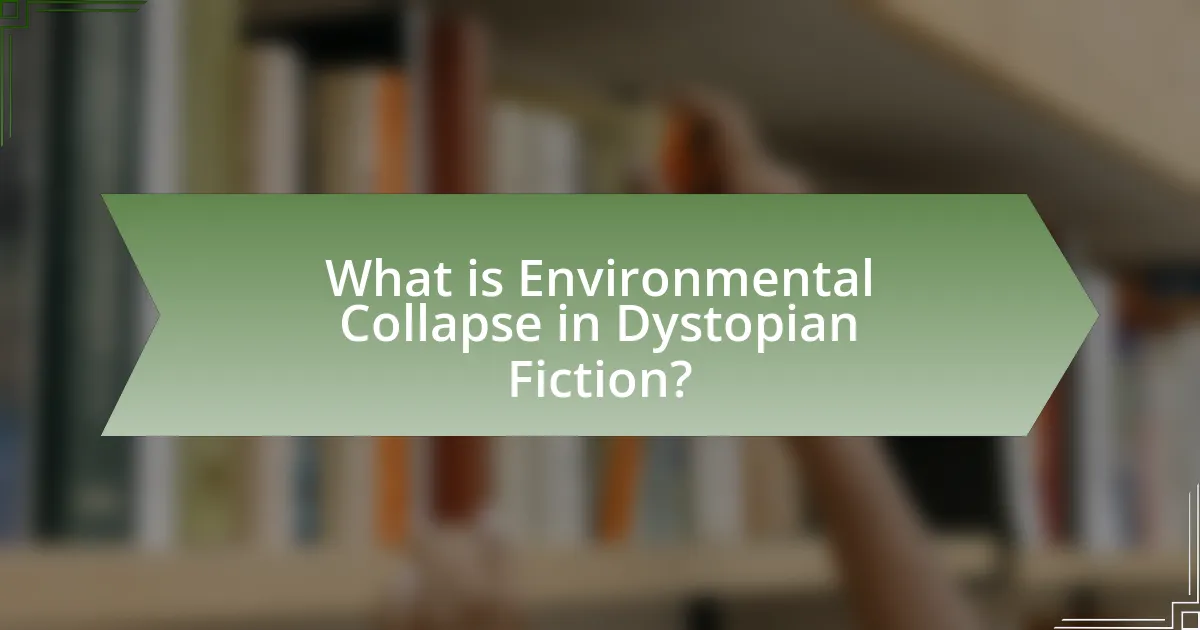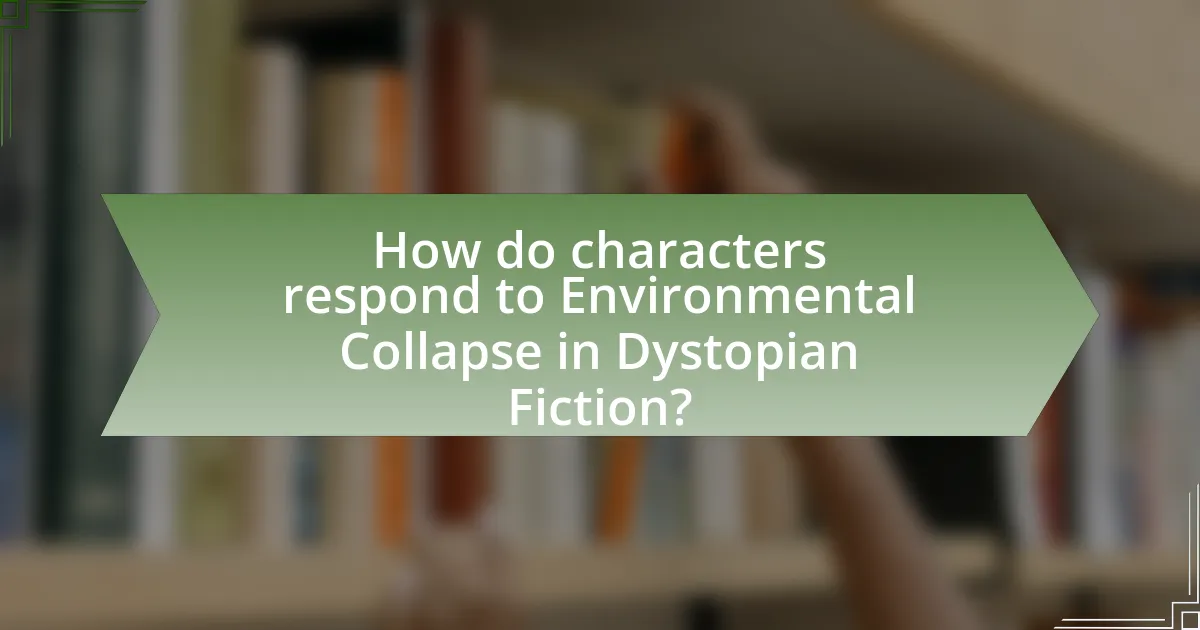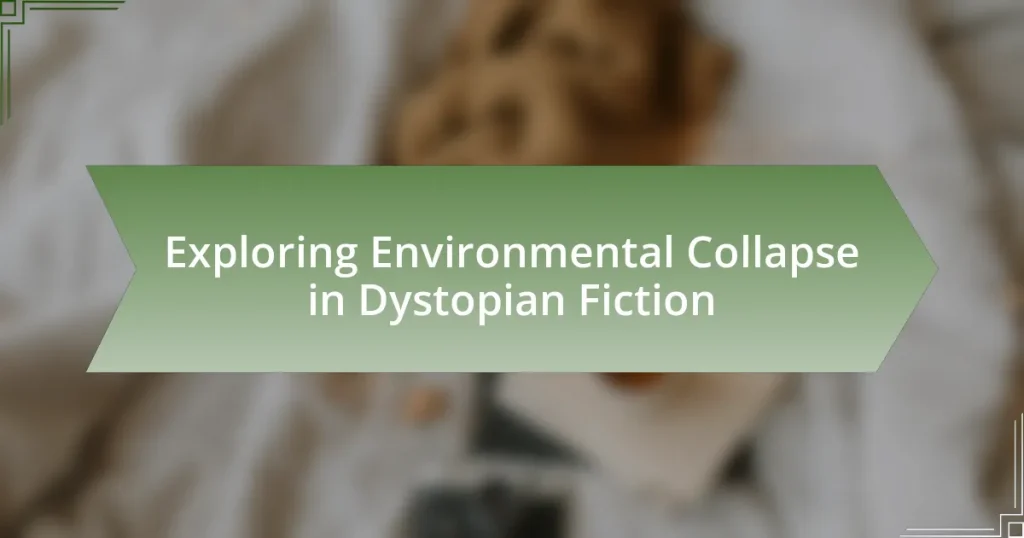Environmental collapse in dystopian fiction refers to the severe degradation of the natural environment, leading to societal breakdown and human suffering. This article explores how this theme is depicted in literature, highlighting notable works such as “The Road” by Cormac McCarthy and “Parable of the Sower” by Octavia Butler. Key topics include the causes of environmental collapse, the role of industrialization and climate change, and the impact on character development and societal dynamics. The article also examines the moral dilemmas faced by characters, the evolution of relationships, and the lessons these narratives impart regarding real-world environmental issues and the need for sustainable practices.

What is Environmental Collapse in Dystopian Fiction?
Environmental collapse in dystopian fiction refers to the catastrophic degradation of the natural environment, leading to societal breakdown and human suffering. This theme often illustrates the consequences of unchecked industrialization, climate change, and resource depletion, showcasing scenarios where ecosystems fail, resulting in famine, disease, and conflict over dwindling resources. Notable examples include works like “The Road” by Cormac McCarthy, which depicts a post-apocalyptic world ravaged by environmental disaster, and “Parable of the Sower” by Octavia Butler, where climate change and social inequality lead to societal collapse. These narratives serve as cautionary tales, reflecting real-world environmental concerns and the potential future consequences of current ecological neglect.
How is environmental collapse depicted in dystopian narratives?
Environmental collapse in dystopian narratives is often depicted through extreme climate change, resource scarcity, and societal breakdown. These narratives illustrate the consequences of environmental neglect, showcasing barren landscapes, polluted cities, and the struggle for survival among characters. For instance, in “The Road” by Cormac McCarthy, the post-apocalyptic world is characterized by ash-covered terrain and a lack of resources, emphasizing the dire effects of environmental degradation. Similarly, “Parable of the Sower” by Octavia Butler presents a future where climate change has led to societal collapse, highlighting the impact of environmental factors on human behavior and community dynamics. These depictions serve as cautionary tales, reflecting real-world concerns about ecological sustainability and the potential for catastrophic outcomes if current environmental issues are not addressed.
What are the common themes associated with environmental collapse in these stories?
Common themes associated with environmental collapse in dystopian fiction include the consequences of climate change, resource scarcity, and societal breakdown. These narratives often depict a world where ecological degradation leads to extreme weather events, loss of biodiversity, and depletion of natural resources, resulting in conflict and societal disintegration. For instance, in works like “The Road” by Cormac McCarthy, the aftermath of environmental disaster creates a bleak landscape where survival is paramount, illustrating the dire effects of humanity’s neglect of nature. Similarly, “Parable of the Sower” by Octavia Butler explores themes of societal collapse due to environmental factors, emphasizing the fragility of civilization in the face of ecological crises. These stories serve as cautionary tales, reflecting real-world concerns about environmental sustainability and the potential future consequences of current practices.
How do authors use setting to illustrate environmental degradation?
Authors use setting to illustrate environmental degradation by depicting landscapes that reflect the consequences of ecological neglect and climate change. For instance, in dystopian fiction, settings often feature barren wastelands, polluted cities, or decaying natural environments, which serve as a backdrop to the narrative and symbolize the impact of human actions on the planet. A notable example is Cormac McCarthy’s “The Road,” where the desolate, ash-covered landscape emphasizes the severity of environmental collapse and its effects on survival. This portrayal not only enhances the emotional weight of the story but also serves as a critique of contemporary environmental issues, illustrating the potential future consequences of current practices.
Why is environmental collapse a significant theme in dystopian fiction?
Environmental collapse is a significant theme in dystopian fiction because it reflects societal anxieties about ecological degradation and its consequences for humanity. This theme serves as a cautionary tale, illustrating the potential outcomes of neglecting environmental issues, such as climate change, resource depletion, and pollution. For instance, novels like “The Road” by Cormac McCarthy depict a post-apocalyptic world ravaged by environmental disaster, emphasizing the fragility of human existence in the face of ecological collapse. Such narratives resonate with readers by highlighting the urgent need for sustainable practices and awareness of environmental stewardship, making the theme both relevant and impactful in contemporary discourse.
What societal fears does environmental collapse reflect in literature?
Environmental collapse in literature reflects societal fears of loss of control, existential threats, and the consequences of human negligence. These narratives often depict scenarios where ecological degradation leads to societal breakdown, illustrating anxieties about climate change, resource scarcity, and the fragility of civilization. For instance, in works like “The Road” by Cormac McCarthy, the collapse of the environment results in a dystopian world where survival is paramount, highlighting fears of societal disintegration and loss of humanity. Such literature serves as a cautionary tale, emphasizing the urgent need for environmental stewardship and the potential repercussions of inaction.
How does environmental collapse influence character development in these narratives?
Environmental collapse significantly influences character development in dystopian narratives by forcing characters to confront survival challenges and moral dilemmas. As ecosystems deteriorate, characters often experience profound transformations, adapting to harsh realities that test their values and relationships. For instance, in “The Road” by Cormac McCarthy, the father and son navigate a post-apocalyptic landscape, which deepens their bond and highlights themes of hope and despair. This environmental backdrop compels characters to make difficult choices, revealing their true nature and resilience in the face of adversity. Such narratives illustrate how environmental degradation serves as a catalyst for character growth, emphasizing the interplay between external circumstances and internal evolution.

What are the causes of Environmental Collapse in Dystopian Fiction?
The causes of environmental collapse in dystopian fiction often stem from unchecked industrialization, climate change, and resource depletion. These narratives typically illustrate how rapid technological advancement leads to ecological degradation, as seen in works like “The Road” by Cormac McCarthy, where a post-apocalyptic world results from environmental neglect. Additionally, societal factors such as political corruption and corporate greed exacerbate these issues, leading to a breakdown of ecosystems and societal structures. For instance, in “Parable of the Sower” by Octavia Butler, the collapse is driven by economic disparity and environmental neglect, highlighting the interconnectedness of social and ecological crises.
How do human actions contribute to environmental collapse in these stories?
Human actions contribute to environmental collapse in these stories primarily through exploitation of natural resources and neglect of ecological balance. For instance, characters often engage in deforestation, pollution, and industrialization without regard for the long-term consequences, leading to habitat destruction and climate change. In “The Road” by Cormac McCarthy, the aftermath of unchecked industrial activity results in a barren landscape, illustrating the direct link between human greed and environmental degradation. Similarly, in “Parable of the Sower” by Octavia Butler, societal collapse is depicted as a result of resource depletion and social inequality, showcasing how human decisions exacerbate ecological crises. These narratives serve as cautionary tales, emphasizing the urgent need for sustainable practices to prevent real-world environmental collapse.
What role does industrialization play in the narratives of environmental collapse?
Industrialization serves as a central catalyst in the narratives of environmental collapse, illustrating the detrimental impact of rapid industrial growth on ecosystems. The process of industrialization often leads to increased pollution, resource depletion, and habitat destruction, which are frequently depicted in dystopian fiction as direct consequences of unchecked technological advancement. For instance, in works like “The Road” by Cormac McCarthy, the aftermath of industrial exploitation is portrayed through a desolate landscape, highlighting the stark realities of environmental degradation. Additionally, historical data shows that since the Industrial Revolution, carbon emissions have surged, contributing significantly to climate change and biodiversity loss, which are common themes in dystopian narratives. Thus, industrialization is portrayed as a driving force behind environmental collapse, emphasizing the urgent need for sustainable practices.
How is climate change represented in dystopian fiction?
Climate change is represented in dystopian fiction as a catalyst for societal collapse and environmental degradation. In many narratives, extreme weather events, rising sea levels, and resource scarcity serve as backdrops that highlight the consequences of humanity’s neglect of the environment. For instance, in “The Water Knife” by Paolo Bacigalupi, the struggle for dwindling water resources illustrates the dire impacts of climate change on society and individual survival. This representation often emphasizes themes of inequality, as marginalized communities face the brunt of environmental disasters, reflecting real-world disparities exacerbated by climate change. Such depictions serve as cautionary tales, urging readers to confront the potential realities of unchecked environmental neglect.
What external factors exacerbate environmental collapse in these narratives?
External factors that exacerbate environmental collapse in dystopian narratives include industrialization, climate change, and resource depletion. Industrialization leads to increased pollution and habitat destruction, as seen in narratives where unchecked technological advancement results in ecological degradation. Climate change is often depicted as a catalyst for extreme weather events and rising sea levels, further destabilizing ecosystems and human societies. Resource depletion, particularly of water and arable land, creates competition and conflict among populations, intensifying the collapse. These factors are frequently illustrated through scenarios where societal collapse is a direct consequence of environmental mismanagement and exploitation, highlighting the interconnectedness of human actions and ecological health.
How do natural disasters feature in the context of dystopian settings?
Natural disasters prominently feature in dystopian settings as catalysts for societal collapse and environmental degradation. In many dystopian narratives, events such as floods, earthquakes, and climate change lead to the breakdown of social order, illustrating humanity’s vulnerability to nature’s forces. For instance, in the novel “The Road” by Cormac McCarthy, a post-apocalyptic landscape ravaged by an unspecified disaster showcases the dire consequences of environmental collapse, emphasizing themes of survival and despair. Such disasters often serve as a backdrop for exploring human resilience and moral dilemmas in the face of overwhelming adversity, reinforcing the notion that environmental crises can precipitate profound societal transformations.
What impact do political and economic systems have on environmental degradation?
Political and economic systems significantly influence environmental degradation through policies, regulations, and resource management practices. For instance, capitalist economies often prioritize profit maximization, leading to over-exploitation of natural resources and increased pollution, as evidenced by the rapid industrialization seen in countries like China, which has resulted in severe air and water quality issues. Conversely, political systems that enforce strict environmental regulations, such as those in Scandinavian countries, tend to mitigate degradation by promoting sustainable practices and renewable energy sources. Research indicates that nations with democratic governance structures are more likely to implement effective environmental policies, as seen in the European Union’s stringent environmental standards, which aim to reduce carbon emissions and protect biodiversity.

How do characters respond to Environmental Collapse in Dystopian Fiction?
Characters in dystopian fiction typically respond to environmental collapse through a range of actions, including adaptation, rebellion, and survivalism. For instance, in “The Road” by Cormac McCarthy, the protagonists exhibit extreme survival instincts, scavenging for food and shelter in a desolate landscape, illustrating the instinctual drive to endure despite dire circumstances. In contrast, characters in “Parable of the Sower” by Octavia Butler actively seek to change their environment by forming communities and creating new belief systems, showcasing a proactive approach to the challenges posed by ecological degradation. These responses reflect the broader themes of resilience and the human capacity to confront and navigate the consequences of environmental crises, as evidenced by the diverse strategies characters employ to cope with their deteriorating world.
What survival strategies do characters employ in response to environmental collapse?
Characters in dystopian fiction employ various survival strategies in response to environmental collapse, including resourcefulness, community building, and adaptation to new realities. Resourcefulness is often demonstrated through scavenging for food, water, and shelter, as seen in works like “The Road” by Cormac McCarthy, where the protagonists utilize their surroundings to survive. Community building is crucial, as characters often form alliances or groups to enhance their chances of survival, exemplified in “Station Eleven” by Emily St. John Mandel, where survivors create a traveling symphony to maintain culture and support each other. Adaptation to new realities involves learning new skills, such as farming or hunting, to cope with the scarcity of resources, which is a common theme in “The Hunger Games” series by Suzanne Collins, where characters must adapt to a harsh environment to survive. These strategies highlight the resilience and ingenuity of characters facing dire circumstances.
How do characters adapt to their changing environments?
Characters adapt to their changing environments by altering their behaviors, forming new alliances, and developing survival strategies. In dystopian fiction, such adaptations often reflect the harsh realities of environmental collapse, where characters must navigate scarcity, societal breakdown, and shifting power dynamics. For instance, in “The Road” by Cormac McCarthy, the protagonists adapt by scavenging for food and avoiding hostile groups, showcasing their resilience in a desolate landscape. This illustrates how characters’ adaptability is crucial for survival in the face of drastic environmental changes.
What moral dilemmas do characters face in the wake of environmental disaster?
Characters in the wake of environmental disaster face moral dilemmas such as prioritizing survival over ethical considerations, grappling with the consequences of resource scarcity, and making decisions that impact the greater good versus individual needs. For instance, in dystopian narratives, characters often confront the choice between hoarding limited resources for themselves or sharing with others, which can lead to conflict and ethical questioning about altruism versus self-preservation. Additionally, they may struggle with the implications of their actions on the environment, such as whether to exploit remaining natural resources for immediate survival or to conserve them for future generations, reflecting the tension between short-term needs and long-term sustainability. These dilemmas are underscored by the harsh realities of environmental degradation, where the collapse of ecosystems forces individuals to reconsider their values and responsibilities in a drastically altered world.
How do relationships evolve in the context of environmental collapse?
Relationships evolve in the context of environmental collapse by becoming more interdependent and adaptive as individuals and communities face shared challenges. In dystopian fiction, characters often form alliances based on survival needs, leading to stronger bonds forged through adversity. For example, in works like “The Road” by Cormac McCarthy, the relationship between the father and son deepens as they navigate a desolate landscape, highlighting the necessity of trust and cooperation in dire circumstances. This evolution reflects a shift from individualism to collectivism, where emotional connections are prioritized for mutual support in the face of resource scarcity and societal breakdown.
What role does community play in survival during environmental crises?
Community plays a crucial role in survival during environmental crises by providing social support, resource sharing, and collective action. During such crises, individuals often rely on their community for emotional and practical assistance, which can enhance resilience. For instance, studies have shown that communities with strong social ties are better equipped to respond to disasters, as they can mobilize resources and coordinate efforts more effectively. Research published in the journal “Environmental Science & Policy” highlights that communities that engage in collaborative planning and resource management are more successful in adapting to environmental changes. This collective approach not only fosters a sense of belonging but also increases the likelihood of survival in challenging circumstances.
How do personal relationships change under the stress of environmental collapse?
Personal relationships often become strained and fragmented under the stress of environmental collapse. As resources become scarce and survival becomes a priority, individuals may prioritize their immediate family or close allies over broader social connections, leading to increased isolation from extended networks. Research indicates that during crises, such as natural disasters or societal breakdowns, people tend to form tighter bonds with those they perceive as essential for survival, while simultaneously distancing themselves from others perceived as threats or burdens. For example, studies on community responses to environmental disasters show that social cohesion can initially strengthen, but as prolonged stressors persist, conflicts over resources can lead to distrust and breakdowns in communication among friends and neighbors.
What lessons can be learned from Environmental Collapse in Dystopian Fiction?
Environmental collapse in dystopian fiction teaches critical lessons about the consequences of neglecting ecological sustainability. These narratives often illustrate the dire outcomes of environmental degradation, such as resource scarcity, societal breakdown, and loss of biodiversity. For instance, in “The Road” by Cormac McCarthy, the bleak landscape serves as a stark reminder of the potential future resulting from climate change and human apathy. Additionally, works like “Parable of the Sower” by Octavia Butler highlight the importance of adaptability and community resilience in the face of ecological crises. These stories emphasize the need for proactive environmental stewardship and the dangers of ignoring scientific warnings, reinforcing the urgency for sustainable practices in contemporary society.
How can readers apply insights from these narratives to real-world environmental issues?
Readers can apply insights from narratives about environmental collapse in dystopian fiction by recognizing the consequences of neglecting ecological systems and the urgency of sustainable practices. These stories often illustrate the dire outcomes of environmental degradation, such as resource scarcity and societal breakdown, prompting readers to reflect on current environmental challenges like climate change and biodiversity loss. For instance, the portrayal of water shortages in dystopian settings can parallel real-world issues, encouraging individuals to advocate for water conservation and responsible resource management. By drawing parallels between fictional scenarios and actual environmental crises, readers can foster a sense of responsibility and urgency to engage in proactive measures, such as supporting policies aimed at environmental protection and participating in community sustainability initiatives.
What are the implications of these stories for future environmental policy and action?
The implications of stories exploring environmental collapse in dystopian fiction suggest that future environmental policy and action must prioritize sustainability and resilience. These narratives often illustrate the catastrophic consequences of neglecting ecological balance, highlighting the urgency for proactive measures. For instance, the portrayal of resource scarcity and societal breakdown in works like “The Road” by Cormac McCarthy emphasizes the need for policies that promote conservation and responsible resource management. Such fiction serves as a cautionary tale, reinforcing the importance of integrating scientific research and community engagement into environmental strategies to prevent real-world scenarios depicted in these stories.




